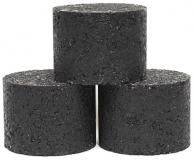“Just dump it in!” sighed an exasperated technician. “We have lots of samples to run today. We can’t take all day just filling the molds.”
Experts say that much of the variability in test results comes from the sample preparation process. Everyone wants consistent test results. They are achievable for those willing to invest in proper sample preparation procedures.
How one fills a mold with hot asphalt for compaction affects the amount of aggregate segregation. Segregation in the mix leads to non-uniform specimens. And, non-uniform specimens lead to inconsistent test results.
So what is it one can do to minimize segregation of hot asphalt when placing it in a mold for compaction? Here are two suggestions.
Suggestion #1: Acquire a thin, flexible Teflon mat. Place the heated, ready-for-compaction asphalt on the Teflon mat in a windrow. Roll the mat into a tube around the asphalt material. The tube diameter must be smaller than the diameter of the specimen being made. Place a properly prepared mold on its side. Slide the rolled Teflon tube containing the asphalt into the mold as far as it will go. Tilt the mold upright. Lift the Teflon tube out of the mold. And finally, proceed with compacting your specimen.
Suggestion #2: Acquire a section of 6” PCV pipe. Prepare the PVC pipe by cutting a slot out of pipe length wise so that the pipe forms a trough. Lay the pipe on its side with the open side facing up. Place hot, ready-to-compact asphalt in the pipe. Place a properly prepared mold on its side. Slide the asphalt-laden PVC pipe trough into the mold as far as it will go. Set the mold upright. Pull the pipe out of the mold. And lastly, proceed with compacting your specimen.
Either approach will prevent the freefall of material as it is placed in a mold thus limiting segregation of the asphalt. Non-segregated material produces more uniform specimens. More uniform specimens improve consistency of test results on the specimens. Consistent test results make confident lab technicians.




